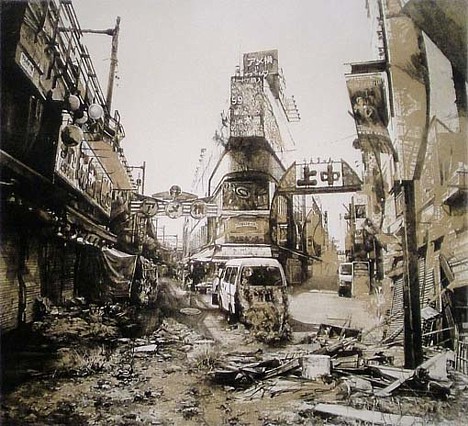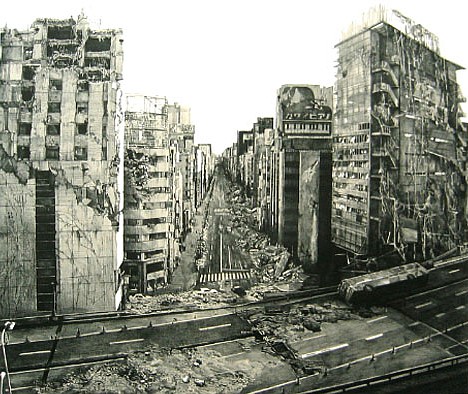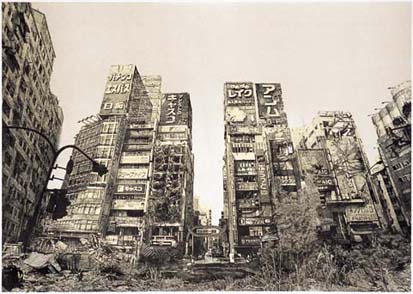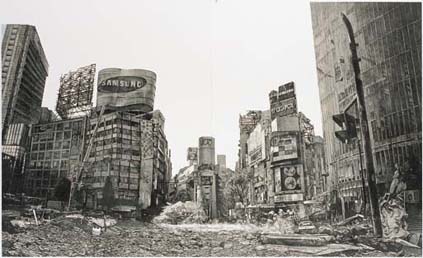 [Image: Ameyoko by Hisaharu Motoda; via Pink Tentacle].
[Image: Ameyoko by Hisaharu Motoda; via Pink Tentacle].
On Wired today, we read that “Japanese photographer Hisaharu Motada [sic] envisions the radioactive and decomposing cityscapes of post-apocalyptic Tokyo in his Neo-Ruins series of photographs.”
 [Image: Ginza Chuo Dori by Hisaharu Motoda; via Pink Tentacle].
[Image: Ginza Chuo Dori by Hisaharu Motoda; via Pink Tentacle].
From Motoda’s own website:
In his Neo-Ruins series Motoda depicts a post-apocalyptic Tokyo, where familiar landscapes in the central districts of Ginza, Shibuya, and Asakusa are reduced to ruins and the streets eerily devoid of humans. The weeds that have sprouted from the fissures in the ground seem to be the only living organisms. “In Neo-Ruins I wanted to capture both a sense of the world’s past and of the world’s future,” he explains.
The resulting images are actually lithographs, heavily textured, like aged prints.


 [Images: Kabukicho, Shibuya Center Town, and Electric City by Hisaharu Motoda].
[Images: Kabukicho, Shibuya Center Town, and Electric City by Hisaharu Motoda].
Of course, Motoda’s website hosts a number of other works, including this awesome image of Hashima, or Gunkanjima Island, the wonderfully creepy abandoned former mining island off the coast of Japan.
 [Image: Hashima by Hisaharu Motoda].
[Image: Hashima by Hisaharu Motoda].
So who’s up for making lithographs of a post-apocalyptic Cairo…? Or Chicago, or Mumbai? I’ll write the wall-text.
(Also found via Pink Tentacle).
Stunning. As someone who lives in Cairo, I can only say that there are parts of the city that look similar anyway. As the five-storey brick tenements are thrown up, as they creep closer to the river-cliffs either side of the Nile floodplain, they often sit there for years before tenants move in. As they do so, they slowly decompose, whilst serving as rubbish tips for whoever happens to live close by. One drive around the Cairo orbital road is a strange drive through what Iggy Pop called “the city’s ripped backsides”.
sick. I used to work right on that block in Ginza and seeing it look like this is quite provocative.
The images themselves are great technical achievements, but for those of us who grew up on A Canticle for Liebowitz, William Gibson, Mad Max and, most importantly, Fallout, the work isn’t exactly groundbreaking (pun intended).
Was it the a-bomb or Godzilla?
Citizens of Nagasaki: “Hey, man.. Make happy pictures instead, OK?”
without wishing to sound too much like a weener-liberal hand-wringer… why does sci-fi abound with so much post-apocalyptic “visionary” imagery…
it’s all too easy nowadays to be a doom and gloom mongerer and most recent sci-fi films abound with this…
to borrow a revolutionary portent –
“it’s easy too know what yr fighting against, but not what yr fighting for”
when does eco-tech start turning on minds more than death-wishes?
i am humbled to find myself partly agreeing with the current governator of california – make eco sexy… maybe… but isn’t death imagery sexy?
i thank you and now take a moment to observe the robot tentacles dancing merrily across my building, tending to the vertical gardens…
There’s something i noticed: the quasi-total absence of cars in the picture. Or, better, the absence of anything man-made beside buildings.
No car, no bike, no body.
Just architectural remains.
M
(Ok, there are a couple in the first and a coach in the second one, but it’s far less that one would expect)
anyway, I’ll make the lithographs of Chicago….
beautiful.
a post-apocalyptic mumbai, however, would probably look much the same as it already is.
man has always had a fascination with ruins. to imagine the present as a ruin is to lay waste what man has created and what people define themselves as.
love the revelation. when i saw these images, i went OMFG.
hiroshima boom?
you could go visit Detroit – much of the city looked like this in the 90s.
the world is upside down… our time is a weird time…
i Live in a third world country…abroad people have an apocalyptic vision over here they have apocalyptic power..
Wow! I gotta learn how to do that. I’m also in love with post-apocalyptic work.